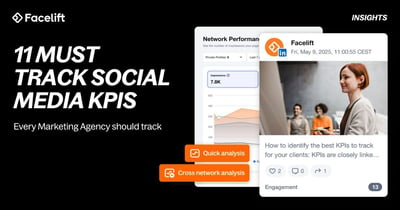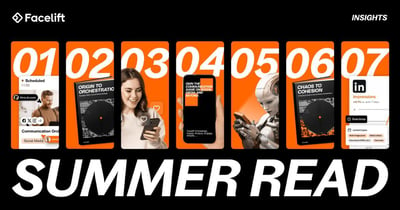Imagine for a moment that you are conducting a symphony. In that symphony, every instrument, every note, aligns perfectly to create the masterpiece you're directing.
Now imagine that you could attain the same level and form of direction with your digital communication strategy. This is what social media orchestration (SMO) promises—the synchronization of every element of your social media strategy to address your organization's numerous business goals.
But, the magic that keeps flawless social media orchestration flowing isn't just creativity, timing, or even teamwork; it's data and analytics and the agility and willingness to act upon them.
Understanding Social Media Orchestration
Social media orchestration isn’t just about managing posts and interactions; it's a sophisticated process that synchronizes various social media activities to create a seamless and powerful brand presence. We've written about it in more depth here, so if you'd like a more comprehensive overview, check this link.
Social media orchestration involves far more than just scheduling content; it requires aligning your social strategies with broader business objectives to maximize impact. The evolution from simple management to full-scale orchestration reflects the increasing complexity of digital marketing. These days, your content: every post, tweet, and short-form video story is part of a larger narrative designed to engage audiences and drive business outcomes.
The Intersection of Data and Social Media Orchestration
At the heart of every truly effective social media strategy lies data and the ability of an organization to use that data to create improvements and avoid pitfalls.
Data provides the insights necessary to make informed decisions about content, audience, and strategy. It guides everything from the tone of your posts to the timing of your campaigns and, of course, your ROI.
Different types of data play distinct roles in SMO:
-
Audience insights: Knowing your audience is the first step in crafting messages that resonate. By analyzing demographic data and behavioral patterns, you can tailor your content to meet the specific needs and interests of your target audience.
-
Engagement metrics: These metrics reveal how your audience interacts with your content, providing valuable feedback on what works and what doesn’t. Understanding these patterns allows you to refine your approach, focusing on strategies that generate the most engagement.
-
Sentiment analysis: Going beyond likes and shares, sentiment analysis digs deeper into how your audience feels about your brand. This type of analysis can highlight areas where your messaging needs to be adjusted to better align with your audience’s perceptions and expectations.
Businesses can use data to create a more focused and effective social media strategy. It helps them to understand what content will engage a given audience, when to post for maximum impact, and how to allocate resources to the strategies that deliver the best return on investment.
Analytics: The Backbone of Effective Social Media Orchestration
While social media orchestration may be a new concept, the idea that data must inform social media activities is not.
But data alone isn’t enough; it’s the analysis of that data that turns raw numbers into actionable insights you can actually use. In social media orchestration, analytics are the tools that allow you to measure performance, track trends, and adjust your strategies with agility.
Some key metrics that should be monitored include:
-
Engagement rates: These tell you how actively your audience is interacting with your content and are a direct measure of its relevance and appeal. This remains an essential KPI for all activities and all departments participating in SMO.
-
Reach: This metric helps you understand how many people are exposed to your content, providing a gauge of your strategy’s effectiveness in expanding your audience. Reach specifically demonstrates how your content is operating within social media's algorithms. It is not itself a great indicator of quality or effectiveness of content. You can be seen by a million people, but if only 10 convert, how is that any better than being seen by 1,000?
-
Conversion rates: Ultimately, social media orchestration aims to drive specific actions, whether that’s making a purchase, signing up for a newsletter, applying for a job, contacting customer service, or simply visiting a website. Conversion rates measure how successful your efforts are in achieving these goals.
Platforms like Facelift Data Studio—our powerful standalone analytics platform—offer extremely granular and advanced analytics features that can help track these metrics and many more, providing businesses with the insights needed to refine their social media strategies continually.
With real-time analytics, you can adjust your campaigns as they unfold, ensuring that every action contributes to your overall business objectives.
Challenges and Solutions in Data-Driven Social Media Orchestration
Data Overload: These days, businesses have access to a positively overwhelming amount of data. Every click, like, share, and comment generates data, creating a vast pool of information that seems great at first glance but can actually be too much!
Without proper tools and strategies for data management in place, sifting through this massive amount of information to find actionable insights can be daunting for businesses that aren't equipped for it. This phenomenon is known as "data overload."
When faced with too much data, businesses may struggle to focus on the most relevant metrics, leading to analysis paralysis—where decision-making becomes hindered by the complexity and abundance of data.
Companies engaged in social media orchestration will inevitable work with a larger density and quantity of data, meaning that a strategic approach to its management is becoming more and more necessary as collection capacity grows.
Data accuracy: Another significant challenge is ensuring the accuracy of the data being analyzed. Inaccurate or incomplete data can lead to misguided strategies, poor reporting, and lost revenue.
For example, if engagement metrics are inaccurately reported, a business might believe a particular type of content is performing well when it’s not, leading to a misallocation of resources.
Inaccurate data can stem from various sources, such as technical errors in data collection, inconsistencies in how data is reported across different platforms, or even user-generated noise that skews the results. To make effective decisions, businesses need to ensure that their data is clean, accurate, and reflective of the true performance of their social media efforts.
To overcome both of these challenges, businesses need to invest in advanced analytics tools that can process large amounts of data and provide clear, actionable insights. It’s also important to train teams on how to interpret and use this data effectively. Integrating data across different platforms can help create a more cohesive approach to SMO, ensuring that your strategies are aligned and consistent.
Facelift Data Studio is the market leader in data collection, processing, and clarity for addressing these challenges head-on. You can read more about it here.
Future Trends: The Evolving Role of Data in Social Media Orchestration
Looking to the future, social media orchestration shows no signs of slowing and will only continue to grow in its scale and applicability.
Emerging technologies like AI and machine learning are poised to revolutionize social media analytics more than they already have, possibly offering predictive capabilities that can anticipate trends and optimize strategies before they’re even implemented.
In the same sense that emerging predictive analytics tools are being press-ganged into service in the investment industry, businesses seeking innovative approaches might explore a motion analytics alternative, which could change the game for social media and communications trends as well.
Businesses can reap the rewards with their approach to social media orchestration if they can be proactive rather than reactive to trends after they’ve already taken hold, as we have usually had to do in the past.
At the same time, businesses will need to navigate the increasing importance of data privacy and ethics, which has already proven to be a major challenge for the social media industry itself as it comes up against more and more regulations in Europe and the United States.
As the collection and analysis of data become more sophisticated, maintaining trust with your audience will be critical, and a strong orchestration plan will be part of developing and maintaining this trust. This will involve not only adhering to legal requirements but also being transparent about how data is collected and used.
Conclusion
Data and analytics are at the core of effective social media orchestration. They provide the insights needed to create strategies that align with business goals, optimize performance, and drive tangible results.
With the right tools and a commitment to continuous learning, businesses can turn social media from a simple marketing channel into a powerful engine for growth.
Facelift offers two separate products to address the need for data in social media orchestration. The first I've already mentioned is Facelift Data Studio, formerly quintly, and a standalone product that serves as the most powerful resource on the market for social media data and analysis.
The second is Facelift Analyze, one of our core tools. It is integrated with all Facelift plans and powered by Facelift Data Studio's technology. It provides a solid overview of your performance and helps produce top-quality reports.
Take a look at both and find out if our data solutions meet your needs! You can also get in touch with one of our product experts for a personal intro here.






